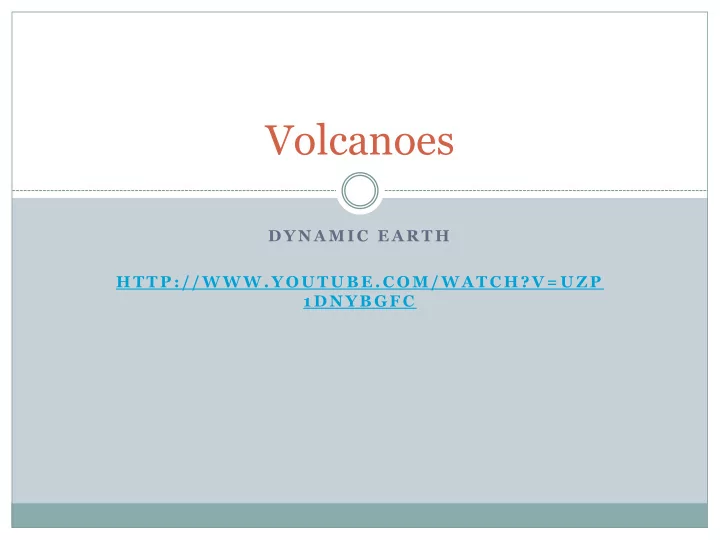

Volcanoes D Y N A M I C E A R T H H T T P : / / W W W . Y O U T U B E . C O M / W A T C H ? V = U Z P 1 D N Y B G F C
What is a volcano? Magma (melted rock inside Earth) bubbles up to Earth’s surface Lava (magma on surface) exits through a vent (opening) Lava cools, solidifies, and builds up to form a mountain (VOLCANO)
Craters and Caldera Crater: bowl shaped depression at top of the volcano surrounding the vent (less than 1 km in diameter) Caldera: large bowl shaped depression that forms when summit collapses into magma chamber (volcano collapses) EX: Crater Lake (Oregon)
Types of Volcanoes: Shield Volcano Shape : large; gentle slope; broad circular base Lava Type : thin, basaltic lava Eruption Type : non-explosive Example : Hawaiian volcanoes
Types of Volcanoes: Cinder-Cone Volcano Shape : small with steep sides Lava Type : thick magma with water and silica Eruption Type : explosive! Example : Izalco volcano; El Salvador
Types of Volcanoes: Composite or Strato-Volcano Shape : medium sized; medium steepness Lava Type : alternating layers of basaltic thin lava and explosive thick lava Eruption Type : most explosive!!, has alternating non-explosive and explosive eruptions Example : Mt. St Helens; Mt. Ranier (Washington)
Tephra Rock fragments thrown into air during volcanic eruptions ; Classified by size: - Dust - Ash - Lapilli “little stones” - Blocks (large & angular) - Volcanic Bombs (large & rounded; cool in air or on contact with ground)
Pyroclastic Flow Cloud of gas, ash, and tephra that comes from explosive eruption Travels nearly 200 km/hr 700 degrees Celsius Mount Pele on island of Martinique in 1902 killed more than 29,000 people
Where do most volcanic eruptions occur? 80% at convergent plate boundaries Ring of Fire : largest ring of volcanic activity around Pacific Plate 15% at divergent plate boundaries (Mid Atlantic Ridge) 5% form away from plate boundaries near hot spots Hot spots: stationary plumes of magma that push up a volcanic island of seamount
Volcano List for the Volcano Research Project You may use any of these volcanoes for your project Novarupta Chaiten Lassen Peak Eyjafjallajökull Mount St. Helens Nevado del Ruiz Kilauea Mount Pelée Muna Loa Cerro Azul Revado del Ruiz Mount Vesuvius Augustine Volcano Tolbachik Redoubt Volcano Mount Awu Mount Pinatubo Fernandina Island Soufriere Hills Volcano El Chichón
Recommend
More recommend